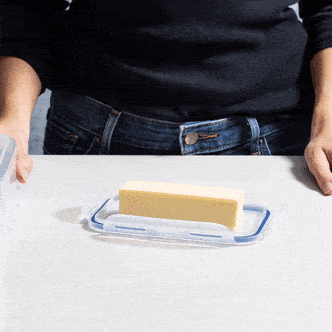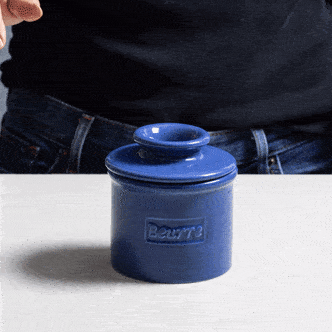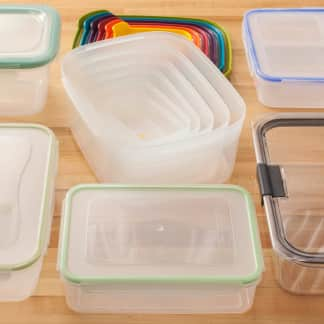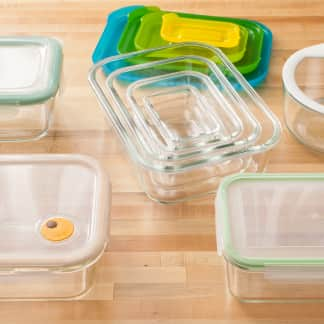We’ve long advocated for storing butter in airtight containers. We especially like two models. If you like having softened butter on hand and want a more elegant storage container that’s intended exclusively for use at room temperature, we suggest a butter bell. Most models are quite similar in size and shape, but we had a slight preference for the Original Butter Bell Crock because it’s spacious and the knob on its lid is large and easy to grasp. We also like the Butterie Flip Top Butter Dish, a classic butter container. It's easy to open, close, and clean, and it's one of the few dishes that is large enough to accommodate wide European-style blocks of butter.

In the test kitchen, we fly through cases of butter. But at home, when we’re cutting off a tablespoon here and there, a single stick can last days or even weeks. During that time, butter can absorb flavors and odors from nearby foods if it’s not stored properly.
Butter storage containers come in two main styles—dishes and bells—and we tested both. The dishes had a surprising number of extra features, including measurement markings, flip-top lids, matching butter knives, and special walls (sometimes called ramps) for wiping knives clean. Butter bells, which originated in France, are intended for use only at room temperature. You pack softened butter into the bell-shaped dish before inserting it upside down into a crock filled with a small amount of water, forming an airtight seal. The water must be changed every few days to keep the butter fresh and prevent mold growth.


For smooth, soft butter that spreads easily across a piece of toast, you might want to consider using a butter bell or our favorite classic butter storage container at room temperature.
To compare the advantages of the two styles and to see which models kept butter freshest for longest, we ran two storage tests. First, we tested a copy of every model at room temperature. Then we tested a second copy of each of the butter dishes in the refrigerator (the bells are not meant for refrigerator use). For each test, we outfitted the containers with freshly unwrapped sticks of butter. At the same time, as a control, we monitored the freshness of two sticks of butter wrapped in the parchment they came in, one refrigerated and one at room temperature. Over several weeks, we checked all the butters daily, looking for signs of spoilage and sampling for rancidity; funky off-flavors acquired from nearby food; and a stale, “fridge-y” taste.

We kept the butter storage containers in the refrigerator for an entire month, checking regularly to see if the butter stored in them changed in appearance or flavor.
Every container protected butter better than the original parchment wrappers did; the wrappers tore and became impossible to reseal tightly, causing the butter to pick up off-flavors. At room temperature, the best storage dishes and bells kept butter fresh for about two weeks. Any longer, and the butter tasted dull instead of fresh and sweet. The butter stored in the butter bells remained pale and uniform in color, but the exteriors of the sticks stored in the containers had darkened slightly.
If you live in a very warm environment and/or want to extend the life of your butter, we suggest storing it in the refrigerator in a butter dish. After three weeks, we were still happy to eat any of the butters in the refrigerated dishes. At the end of a month, the butter stored in one dish remained considerably fresher tasting than those refrigerated in other dishes. To find the container that best fits your needs, consider these key factors.
What to Look For
- Airtight Seals: We especially liked one container that worked like a food storage container, with a tight-fitting lid featuring plastic flaps that snap shut. We also liked the butter bells, which rely on a small amount of water to form an airtight seal around the butter.


Our favorite butter storage containers seal tightly to keep the butter fresh and prevent it from picking up off-flavors. The best butter bell also has a large knob that makes it easy to lift and hold.
- Easy-to-Grab Handles or Knobs: Most butter dishes are lightweight and easy to carry, even if they don’t have handles. But for larger dishes, handles are helpful. Because butter bells are made from heavier, breakable materials such as ceramic and marble, we preferred models with large, easy-to-grasp knobs on their lids.
Nice to Have
- Measurement Markings: If you opt for a butter dish, it’s handy to have a model with tablespoon measurement markings printed on it so that you don’t have to weigh your butter or transfer it to a measuring spoon or measuring cup. Only one model we tested had measurement markings for both East Coast and West Coast sticks (see our FAQs below for more on those regional differences).

It's not essential, but it's handy to have measurement markings on your butter storage container.
What to Avoid
- Big, Tall Containers: One butter dish was shaped like an oval bowl with tall sides. It was awkward to reach into the container to slice butter off the stick.

We preferred containers that made it easy to access the butter. Some had high walls that made it awkward to slice off a bit of butter.
- Narrow Butter Bells: As the name implies, these containers are typically shaped like bells. But one in our lineup was rectangular, charmingly resembling a stick of butter. You have to pack butter tightly into a butter bell to ensure that there are no air pockets where the fat can oxidize and make the butter rancid, so it was hard to get the butter into the edges and corners of that model.
Other Considerations
- Butter Stick Size and Shape Versatility: All the models we tested could comfortably hold ¼-pound sticks of both the long, skinny East Coast–style sticks and the wide, short kind prevalent on the West Coast. Only three models could also hold ½-pound, European-style sticks, so if you want that flexibility, make sure to choose one of them. With the other butter storage containers, you either need to cut the sticks in half or order a different version intended specifically for that style of butter.

Though they vary in shape, the sticks of butter sold along the East Coast and along the West Coast are typically a quarter pound. European-style butters are typically sold in half-pound blocks.
- Check compatibility with a ¼-pound stick of long, skinny East Coast butter
- Check compatibility with a ¼-pound stick of short, wide West Coast butter
- Check compatibility with a ½-pound block of European-style butter
- All models: Store one stick of butter at room temperature for two weeks, evaluating taste and appearance daily
- Butter dishes: Store one stick of butter in the refrigerator for one month, evaluating taste and appearance daily
- Open and close 10 times
- Wash five times according to the manufacturer’s directions






















